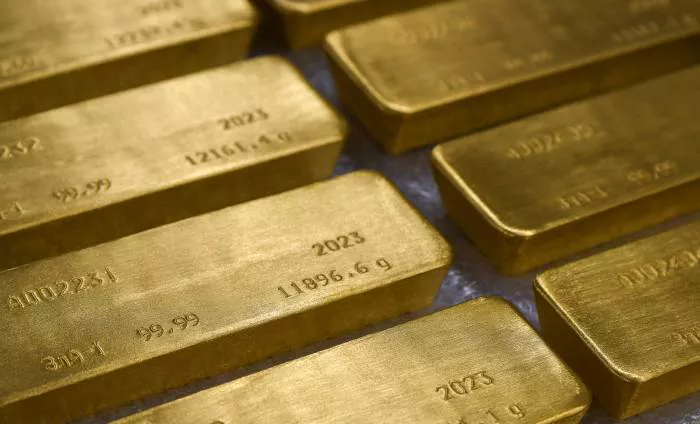Gold prices have surged to new highs, propelled by a global shift towards physical gold as traders pivot away from cash settlements. This move, spurred by uncertainty in U.S. trade policies, has led to soaring gold reserves and stirred global market concerns, particularly impacting India’s gold market.
In the United States, fears of rising tariffs, including potential duties on gold imports, have prompted investors to stockpile physical gold. As a result, gold inventories at the CME Group’s COMEX in New York have nearly doubled, rising from 17.5 million troy ounces in November 2024 to 33.38 million troy ounces by early February 2025.
Jigar Trivedi, Senior Analyst at Reliance Securities, noted that this hoarding trend reflects a broader caution among financial institutions, as risk managers seek to mitigate potential trade-related risks.
Premium for COMEX Futures as Physical Gold Hoarding Intensifies
The rush for physical gold has led to a notable premium on COMEX futures over spot prices. Traders are shifting reserves from traditional gold hubs, such as London, to New York to capitalize on these price differences. This shift has stretched existing systems, with the Bank of England now facing withdrawal delays of up to 4-8 weeks. Meanwhile, bullion banks across Asia are redirecting supplies, and private vaults in New York, operated by HSBC and JPMorgan, have reportedly seen additional shipments.
Impact on India’s Gold Market and Consumer Sentiment
In contrast to the global enthusiasm, India’s gold market is showing signs of caution. Domestic physical gold is trading at a discount compared to futures prices, signaling weak consumer demand. Bhavik Patel, Senior Analyst at Tradebulls Securities, pointed out that high prices have dampened buying interest, contributing to the discount.
This supply disruption is beginning to affect India’s jewelry sector as well. Titan Company, a major player in the market, recently highlighted rising gold lease rates, which they attribute to tightening supply conditions. Vijay Govindarajan, Associate Vice President of Finance at Titan, noted that while banks are addressing supply issues, there is a slight increase in gold lease rates due to the current supply crunch.
On February 5, gold prices hit an all-time high, with India’s price for 10 grams breaching the ₹85,000 mark for the first time on February 4. The precious metal gained up to ₹1,150 per 10 grams in just one day.
Global Rally and Tariff Effects Drive Gold’s 2025 Surge
Amid geopolitical uncertainties, especially U.S. tariffs on Chinese imports and other trade measures, gold prices have surged by nearly 10% in 2025, marking the strongest start since 1980. Central banks worldwide have accelerated gold purchases, with the World Gold Council reporting over 1,000 tonnes of gold added to global reserves in 2024 alone, including a peak of 333 tonnes in the final quarter.
The disruptions in the London gold market, where traders are scrambling to borrow bullion and adjust bar sizes to meet U.S. demand, reflect the far-reaching impact of these developments on gold trading globally.
India’s Jewelry Sector Faces Challenges Amid Tightening Supply
For India, these global forces create a double-edged sword. On one hand, rising international prices and increased demand highlight gold’s role as a safe haven. On the other, subdued local demand and speculative trading signal caution among Indian investors.
As supply chains adjust to unprecedented demand and reserves shift, India’s jewelry sector faces growing cost pressures. With domestic consumers cautious in the face of high prices, the sector may struggle to keep up with global supply fluctuations. Market participants in India are now closely monitoring global dynamics, hoping that adjustments in financing terms and loan-to-value (LTV) ratios will bring some relief in the coming months.
Related topics:
- India Surpasses China in Gold Purchases, Buying 51% More in Three Months
- Gold Rates Skyrocket in Chennai on Diwali, 24K Gold Exceeds Rs. 81,000 Per 10 Grams
- Tariff Concerns Drive Gold Withdrawals from Bank of England Vault


